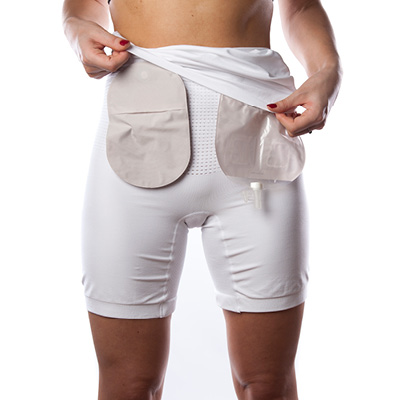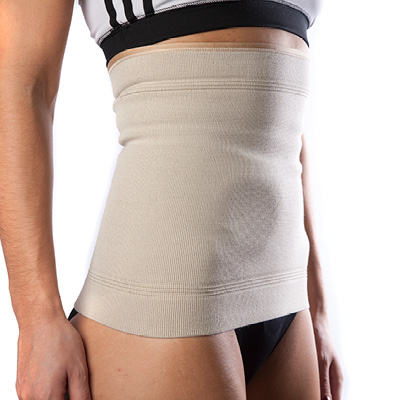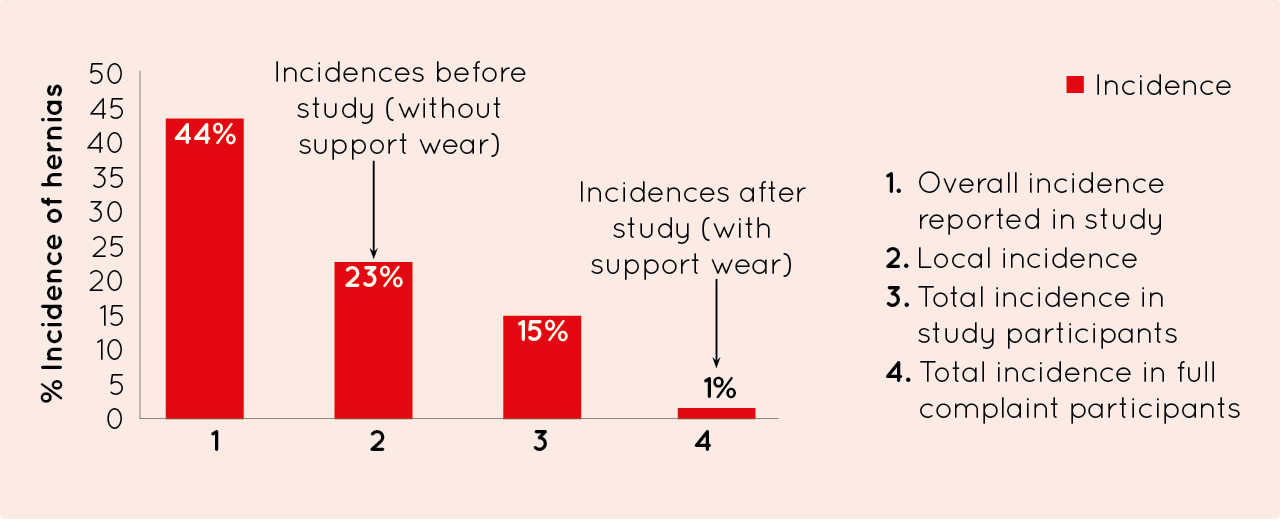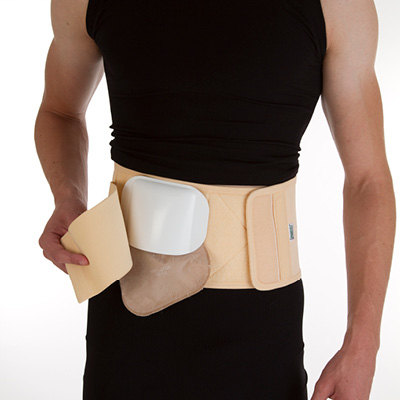Once you’ve had your stoma surgery and you’re well on the way to making a full recovery, you’ll want to get back to normal life. There will of course be a few differences in how you pass food or drink, but you hopefully should be able to continue the rest of life as before.
There shouldn’t be much you did before your surgery that you can’t do once you’ve recovered. However, there are some common complications that can make life more difficult, and you will want to take sensible steps to reduce your risk of these developing.
Parastomal hernias
 Parastomal are one of the most common complications for ostomates. They appear as a bulge in the tummy near the stoma.
Parastomal are one of the most common complications for ostomates. They appear as a bulge in the tummy near the stoma.
When a stoma is formed, a hole is made in the abdominal muscles to pass the stoma through. This hole becomes a potential weak spot in a wall of muscle that holds everything inside in its right place. If this spot isn’t supported, internal pressure can push another piece of bowl through the muscle, forming a hernia under the skin. Once a hernia has appeared, if it is not held in place, it will likely grow in size and can become uncomfortable. A hernia can have a number of unfortunate effects on life quality:
As it changes the shape of the stoma and surrounding skin, it becomes more difficult to attach an appliance. This increases the chances of leaks, which can make the skin sore
• These changes in body shape can also affect self-confidence and desire to socialise
• Larger hernias can make it hard to bend over, and so restrict movement and fitness
• Very large hernias can cause the bowel to become trapped, which is a serious problem that requires urgent surgery.


Ostomy (left) and ostomy with a parastomal hernia (right)
Hernia risk factors
• Lack of support
• Strenuous physical activity
• Weight gain
• Smoking
• Coughing
• Wound infection
Reducing the risk
 Having stoma surgery may not have been in your control, but from here on in you do have a lot of control over your health. With the support and advice of your stoma care nurse, you should be able to make the decisions to hugely reduce your risk of developing a hernia.
Having stoma surgery may not have been in your control, but from here on in you do have a lot of control over your health. With the support and advice of your stoma care nurse, you should be able to make the decisions to hugely reduce your risk of developing a hernia.
There are a few simple abdominal exercises that, if you do every day, should help strengthen core muscles and make sure your muscle wall is strong enough to not let a hernia through. As soon as you feel well enough, ask your stoma care nurse to show these to you or put you in touch with a physiotherapist who can help.
As extra bodyweight increases the pressure on your tummy muscles, try to stay in shape as best you can with a healthy diet and appropriate physical activity. Smoking also increases your risk, so take this as another reason to quit tobacco. Both these steps have masses of other health benefits, and there’s no better time to start.
One of the easiest and most effective measures is to wear specially made support garments. The lightest of these just replace regular underwear. If the stoma site becomes infected for any reason, the muscle is likely to be weaker, so be especially careful and support it while it heals. Likewise, if you have a persistent cough, you should be especially careful to stay supported.
Any physical activity or exercise that strains the abdominal muscles, especially if it involves heavy lifting, is a huge risk for a hernia, so must only be attempted if you are wearing appropriate support gear.
The evidence
If you’re having doubts about swapping your Kalvin Klein’s for stoma support wear, you might want to look at the evidence. Past studies have shown that people who don’t take adequate precautions after stoma surgery have a one-in-two chance of developing a hernia within 2 years.1
Luckily, a lot of work by stoma care nurses and ostomy companies has gone into developing ways to reduce this risk, and evidence suggests that these work. A recent study from Queen’s Hospital London looked at the chance of developing a hernia in the year after surgery. Of those who did not wear a support garment, 23% had a hernia. Meanwhile, in those who were asked to wear Comfizz light support wear in place of regular underwear every day for a year, the chance of having a hernia went down to just 1%. These patients were followed up every three months to check they were wearing the garments and to offer firmer support as they recovered and became more active. The results are shown below.2

1Carne PWG, Robertson GM, Frizelle FA. Parastomal hernia. Br J Surg. 2003; 90(7):784–93
2North J. Early intervention, parastomal hernia and quality of life. Br J Nurs. 2014; 23(Sup5):S14–8
Keeping it up

Ostomy support wear is designed to give you the comfort, confidence and protection that you need, in ways that go beyond hernia protection.
By helping hold your appliance in place, these garment supports the weight of the bag as it fills, reducing the dragging feeling that can occur. When worn in bed, this can contribute towards a peaceful night’s sleep. Meanwhile, the gentle pressure helps the pouch stay adhered to your body, and, if an accident does occur, it can be a life saver, giving you those vital extra minutes to get to a place where the pouch can be changed as soon as possible to prevent skin excoriaton
Support wear can also boost self-confidence in a number of ways. It can streamline your body shape and reduce the visible bulge from the bag, which can be a real bonus, especially when dressing to impress. Support garments cover your stoma site, even if you have a higher-than-average waist height. This gives you the discretion you need in circumstances where you don’t want others to see your bag, such as in a changing room. Likewise, when your bag is supported and hidden, it is much less likely to intrude on intimate moments.
Levels of support
Level 1 Light support is suitable and for everyday wear after surgery in place of regular underwear and is where you’ll find the broadest range of choice
Level 2 Medium support offers firmer support and is suitable for periods of exercise, people with manual occupations and those managing a hernia
Level 3 Firm support refers to belts that provide the strongest level of support, appropriate for heavy lifting, vigorous exercise or managing larger hernias

What’s right for you
 There are a variety of companies that produce different ranges of support wear for different needs, and it’s important to get the right garment for you personally. You want to look for something that has:
There are a variety of companies that produce different ranges of support wear for different needs, and it’s important to get the right garment for you personally. You want to look for something that has:
• The correct level of support
• A good fit
• A style and colour you like.
You may want to consider the fabrics used in each range. Support wear from Comfizz uses breathable wicking fabrics to help you to stay cool and dry, as well as containing two-way stretch knit, which offers complete freedom of movement.
The garment companies have websites and brochures that you can browse to educate yourself on what’s available. Speak to your stoma care nurse, as they can offer professional advice on what suits your needs you, and they can help you order samples or add items to your prescription. To get the full benefits, you will need enough garments to replace regular underwear every day between wash cycles. Most support garments are available on NHS prescription, although quantity you are allowed each year will depend on your GP and stoma care nurse.
Support wear companies
• Comfizz
• Respond
• Salts
• SupportX
• Tytex
Wearing it
Supportive underwear may not have been your passion before stoma surgery, but now it can be your best friend when it comes to your comfort and protection. To get these benefits, however, you absolutely have to remember to wear it. If you find yourself with garments that aren’t right for your needs, make sure you swap them for the right thing as soon as possible—don’t just leave them in the drawer and hope for the best! It is far more cost-effective and comfortable to take the right precautions to avoid a hernia than to manage one once it has appeared. Don’t wait, and fill your ostomy wardrobe.
 Lorraine Alikhanizadeh is the Managing Director of Comfizz
Lorraine Alikhanizadeh is the Managing Director of Comfizz
The contents of this page are property of MA Healthcare and should not be reused without permission

